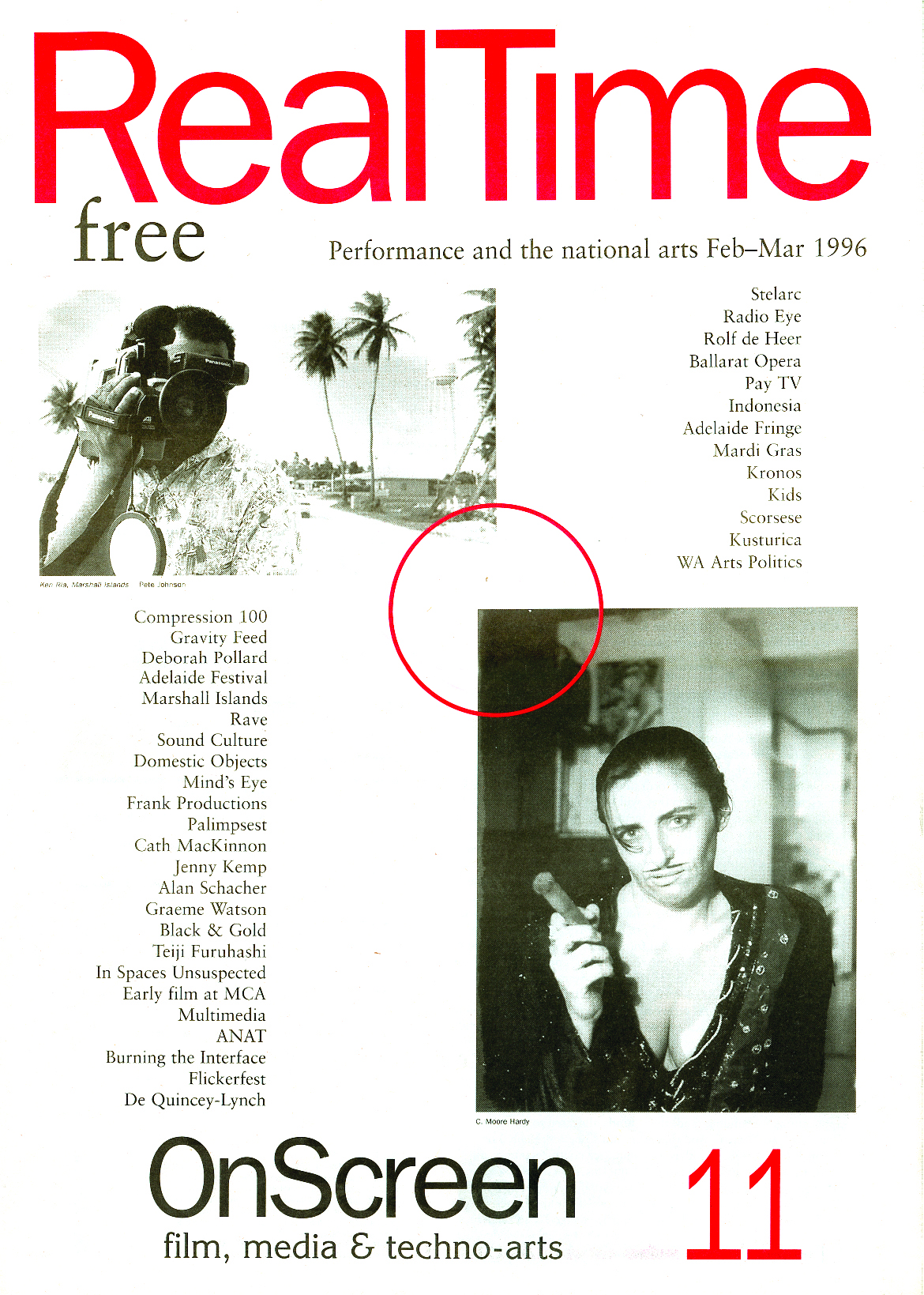
Black & Gold ontology
RealTime Issue 11, February – March 1996, p12
Is this man a kind of Midas turning whatever he touches into the (Black &) Gold of pure art? And the whole world consisting of latent artworks waiting, like the bread and wine of reality, to be transfigured through some dark mystery, into the indiscernible flesh and blood of the sacrament?
– Arthur C. Danto
What is it about inscribing some text on a yellow car, chopping it into little bits and calling it art that captures the imagination? Like all true feats of marketing, Black & Gold Art had something for everyone: violence, colour, action, drama, merchandising, father-son conflict and a bit of theory. It was literally art for the whole family.
There’s something perversely pleasurable in seeing a car (that seemingly indispensable symbol of success in the taken-for-granted world of suburban must-haves) being destroyed by an angle grinder. The media certainly thought so, with Channels 7 & 9 and The West Australian all poised ready to capture the best moments to include in their ‘zany’ segments.
In Black & Gold Art, the sensational aspect was really only a function of necessity: how to get a full sized 1975 Holden Gemini Fastback through the half sized doors of PICA and up the stairs (PICA has no lift). Anyone who followed the car (piece by piece) into the gallery might have noticed the transformative function of this process.
Of course, the other point of fascination was the relationship between artist-son and mechanic-dad. Few artists have not experienced the frustration of trying to explain just what exactly it is they do to bemused parents who only want what’s best for their kids (Surely you want to be a lawyer?). Beyond that, the necessity to defend, justify and name in clearly descriptive and easily understood terms that which is not ‘real’ art is a constant both within and without the family circle. Artist-son’s solution (if not resolution) was to involve his mechanic dad in the project in his own professional capacity.
Beyond which, Mick Hender (the son) discusses the function of objects and their names. What is it that gives a particular object its defining nature and how is this mediated by the packaging and labelling of consumer culture?
The primary gesture of this project was the inscription of the words, “Black & Gold Car” onto the side door and bonnet of a defunct yellow Gemini. Black & Gold (the company) markets itself as a “no frills” corporation. Its strategy is to declare on the packaging of a product exactly what the product is. The text is printed in bold, generic, stencil typeface, in black on a yellow background. No photographs or images embellish the packaging.
The Black & Gold Car, as opposed to regular Black & Gold products, didn’t have any packaging—the text was printed directly onto the surface of the metal bonnet and door. In a sense, packaging and object become one and the object’s name and physical presence become inseparable. The text inscribed on Black & Gold Car, rather than distancing the object itself from its linguistic referent, actually gave the car its essence. Similarly, the assistants working on the project wore Black & Gold overalls. The gallery was painted gold with black lettering. We’re talking Black & Gold in overdrive.
Black & Gold Art also involved the printing of t-shirts to specifications laid down by customer/gallery-goers. The idea began with the printing of Black & Gold T-shirts as a parody of those brand-name t-shirts which function principally to advertise the manufacturer, and rapidly developed into a means of involving people more directly in the experience of Black & Gold Art. Directed by an extensive instruction sheet and order form, customers could designate their size and weight and the title to be printed on a t-shirt. Titles ranged from “Black & Gold Alcoholic Fat Bastard, 90 Kg Nett” to “Black & Gold Fucked Up Homosexual, 69 Kg Nett” to the more straightforward, “Black and Gold Academic, 140 Kg Nett”.
The nature of an object is often defined by what it is not. Ian Ground, writing in Art or Bunk, gives the example of an imaginary meteorite thought to be identical to a Henry Moore sculpture. Ground asks the reader to consider a set of words and their possible application to both meteorite and sculpture. His selections include “witty”, “crass”, “simplistic”, “vulgar”, “original” and so on. He shows that most of these adjectives are inappropriate to describe the meteorite but could, quite plausibly, be used to describe the artwork. Ground’s conclusion, that two identical objects can be different things is effective precisely because of his concrete (albeit imaginary) example. Similarly, Black & Gold Art exists as an example in action: a proposal about the defining nature of objects, products and their packaging.
–
Black & Gold Art was the work of Mick Hender, the artist-son, assisted by Brian Hender, the mechanic-dad. Black & Gold Art was an umbrella project of the 1995 Artrage Festival at the Perth Institute of Contemporary Arts.
Lucas Ihlein, who assisted on Black & Gold Art is a recent graduate of the School of Architecture & Fine Arts, University of Western Australia.






